2006 CHEVROLET EQUINOX height
[x] Cancel search: heightPage 7 of 382
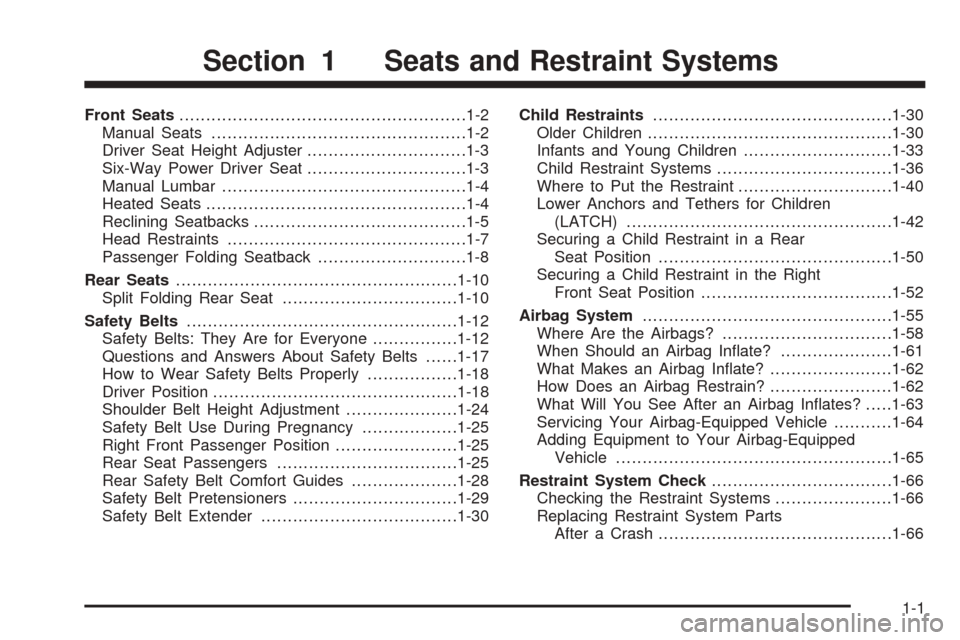
Front Seats......................................................1-2
Manual Seats................................................1-2
Driver Seat Height Adjuster..............................1-3
Six-Way Power Driver Seat..............................1-3
Manual Lumbar..............................................1-4
Heated Seats.................................................1-4
Reclining Seatbacks........................................1-5
Head Restraints.............................................1-7
Passenger Folding Seatback............................1-8
Rear Seats.....................................................1-10
Split Folding Rear Seat.................................1-10
Safety Belts...................................................1-12
Safety Belts: They Are for Everyone................1-12
Questions and Answers About Safety Belts......1-17
How to Wear Safety Belts Properly.................1-18
Driver Position..............................................1-18
Shoulder Belt Height Adjustment.....................1-24
Safety Belt Use During Pregnancy..................1-25
Right Front Passenger Position.......................1-25
Rear Seat Passengers..................................1-25
Rear Safety Belt Comfort Guides....................1-28
Safety Belt Pretensioners...............................1-29
Safety Belt Extender.....................................1-30Child Restraints.............................................1-30
Older Children..............................................1-30
Infants and Young Children............................1-33
Child Restraint Systems.................................1-36
Where to Put the Restraint.............................1-40
Lower Anchors and Tethers for Children
(LATCH)..................................................1-42
Securing a Child Restraint in a Rear
Seat Position............................................1-50
Securing a Child Restraint in the Right
Front Seat Position....................................1-52
Airbag System...............................................1-55
Where Are the Airbags?................................1-58
When Should an Airbag In�ate?.....................1-61
What Makes an Airbag In�ate?.......................1-62
How Does an Airbag Restrain?.......................1-62
What Will You See After an Airbag In�ates?.....1-63
Servicing Your Airbag-Equipped Vehicle...........1-64
Adding Equipment to Your Airbag-Equipped
Vehicle....................................................1-65
Restraint System Check..................................1-66
Checking the Restraint Systems......................1-66
Replacing Restraint System Parts
After a Crash............................................1-66
Section 1 Seats and Restraint Systems
1-1
Page 9 of 382
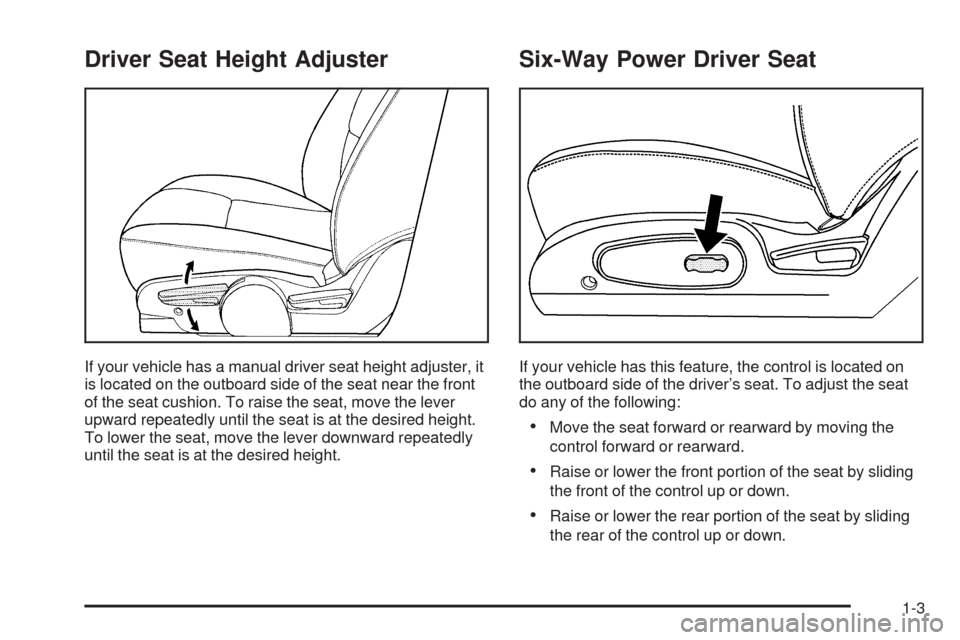
Driver Seat Height Adjuster
If your vehicle has a manual driver seat height adjuster, it
is located on the outboard side of the seat near the front
of the seat cushion. To raise the seat, move the lever
upward repeatedly until the seat is at the desired height.
To lower the seat, move the lever downward repeatedly
until the seat is at the desired height.
Six-Way Power Driver Seat
If your vehicle has this feature, the control is located on
the outboard side of the driver’s seat. To adjust the seat
do any of the following:
Move the seat forward or rearward by moving the
control forward or rearward.
Raise or lower the front portion of the seat by sliding
the front of the control up or down.
Raise or lower the rear portion of the seat by sliding
the rear of the control up or down.
1-3
Page 11 of 382
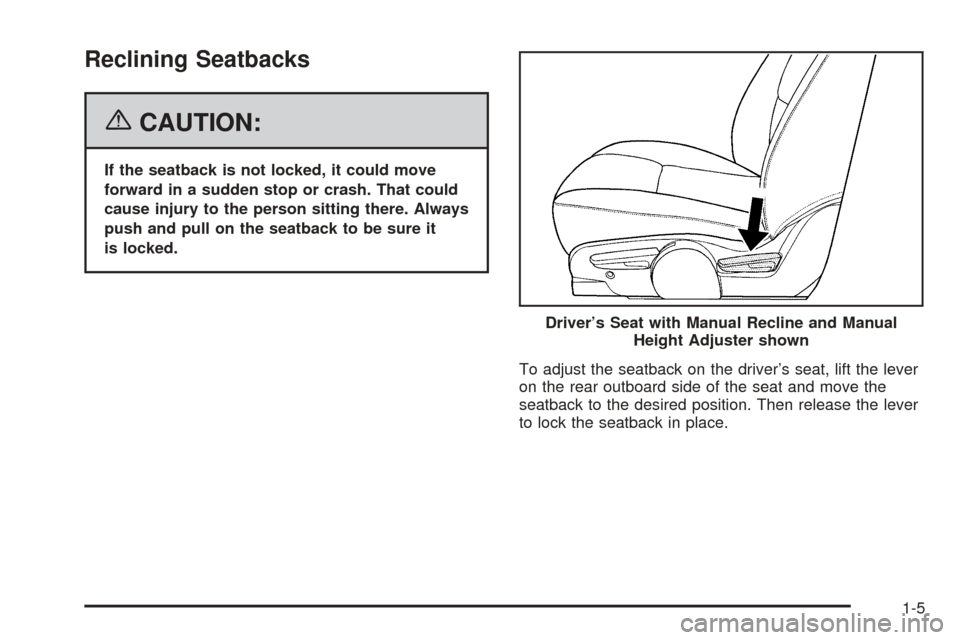
Reclining Seatbacks
{CAUTION:
If the seatback is not locked, it could move
forward in a sudden stop or crash. That could
cause injury to the person sitting there. Always
push and pull on the seatback to be sure it
is locked.
To adjust the seatback on the driver’s seat, lift the lever
on the rear outboard side of the seat and move the
seatback to the desired position. Then release the lever
to lock the seatback in place.Driver’s Seat with Manual Recline and Manual
Height Adjuster shown
1-5
Page 25 of 382
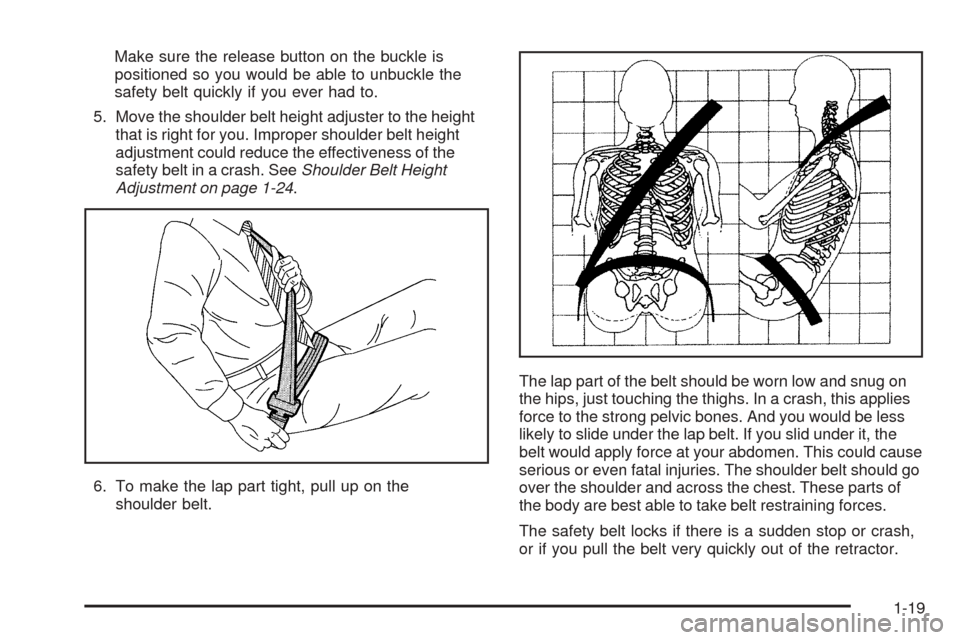
Make sure the release button on the buckle is
positioned so you would be able to unbuckle the
safety belt quickly if you ever had to.
5. Move the shoulder belt height adjuster to the height
that is right for you. Improper shoulder belt height
adjustment could reduce the effectiveness of the
safety belt in a crash. SeeShoulder Belt Height
Adjustment on page 1-24.
6. To make the lap part tight, pull up on the
shoulder belt.The lap part of the belt should be worn low and snug on
the hips, just touching the thighs. In a crash, this applies
force to the strong pelvic bones. And you would be less
likely to slide under the lap belt. If you slid under it, the
belt would apply force at your abdomen. This could cause
serious or even fatal injuries. The shoulder belt should go
over the shoulder and across the chest. These parts of
the body are best able to take belt restraining forces.
The safety belt locks if there is a sudden stop or crash,
or if you pull the belt very quickly out of the retractor.
1-19
Page 30 of 382

To unlatch the belt, just push the button on the buckle.
The belt should go back out of the way.
Before you close the door, be sure the belt is out of the
way. If you slam the door on it, you can damage both the
belt and your vehicle.
Shoulder Belt Height Adjustment
Before you begin to drive, move the shoulder belt height
adjuster to the height that is right for you.
Adjust the height so that the shoulder portion of the belt
is centered on your shoulder. The belt should be away
from your face and neck, but not falling off your shoulder.
Incorrect positioning of the shoulder belt can reduce
the effectiveness of the safety belt.
To move it up or down,
squeeze the release
buttons (A) together and
move the height adjuster
to the desired position.
After you move the height adjuster to where you want it,
try to move it up or down without squeezing the release
buttons to make sure it has locked into position.
1-24
Page 40 of 382
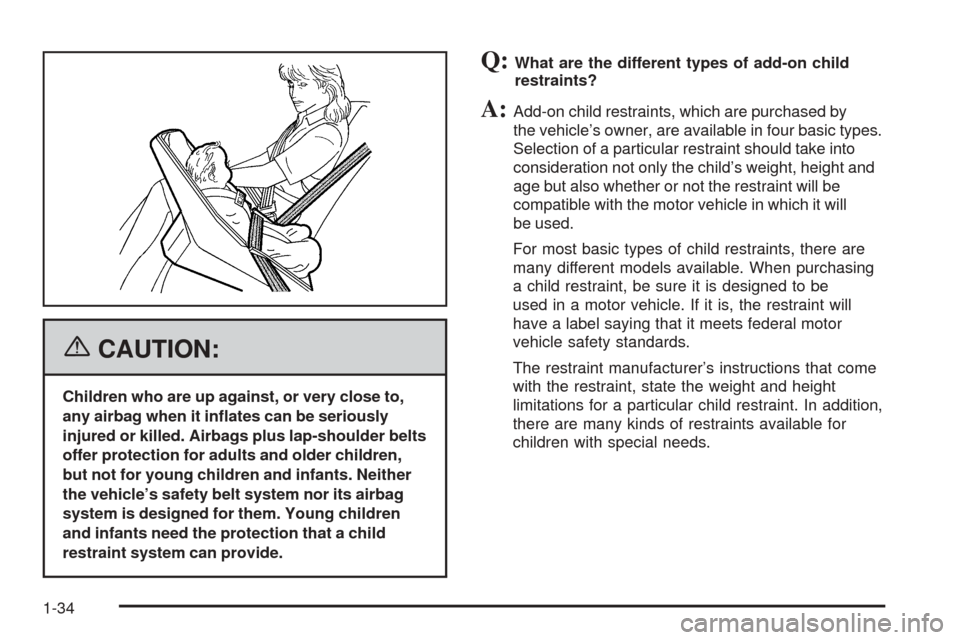
{CAUTION:
Children who are up against, or very close to,
any airbag when it in�ates can be seriously
injured or killed. Airbags plus lap-shoulder belts
offer protection for adults and older children,
but not for young children and infants. Neither
the vehicle’s safety belt system nor its airbag
system is designed for them. Young children
and infants need the protection that a child
restraint system can provide.
Q:What are the different types of add-on child
restraints?
A:Add-on child restraints, which are purchased by
the vehicle’s owner, are available in four basic types.
Selection of a particular restraint should take into
consideration not only the child’s weight, height and
age but also whether or not the restraint will be
compatible with the motor vehicle in which it will
be used.
For most basic types of child restraints, there are
many different models available. When purchasing
a child restraint, be sure it is designed to be
used in a motor vehicle. If it is, the restraint will
have a label saying that it meets federal motor
vehicle safety standards.
The restraint manufacturer’s instructions that come
with the restraint, state the weight and height
limitations for a particular child restraint. In addition,
there are many kinds of restraints available for
children with special needs.
1-34
Page 71 of 382

Adding Equipment to Your
Airbag-Equipped Vehicle
Q:Is there anything I might add to the front or
sides of the vehicle that could keep the
airbags from working properly?
A:Yes. If you add things that change your vehicle’s
frame, bumper system, height, front end or side
sheet metal, they may keep the airbag system from
working properly. Also, the airbag system may
not work properly if you relocate any of the airbag
sensors. If you have any questions about this,
you should contact Customer Assistance before you
modify your vehicle. The phone numbers and
addresses for Customer Assistance are in Step Two
of the Customer Satisfaction Procedure in this
manual. SeeCustomer Satisfaction Procedure on
page 7-2.
Q:Because I have a disability, I have to get my
vehicle modi�ed. How can I �nd out whether
this will affect my airbag system?
A:Changing or moving any parts of the front seats,
safety belts, the airbag sensing and diagnostic
module, steering wheel, instrument panel, ceiling
headliner, ceiling and pillar garnish trim,
roof-mounted airbag modules, or airbag wiring
can affect the operation of the airbag system.
If you have questions, call Customer Assistance.
The phone numbers and addresses for Customer
Assistance are in Step Two of the Customer
Satisfaction Procedure in this manual. See
Customer Satisfaction Procedure on page 7-2.
1-65
Page 101 of 382
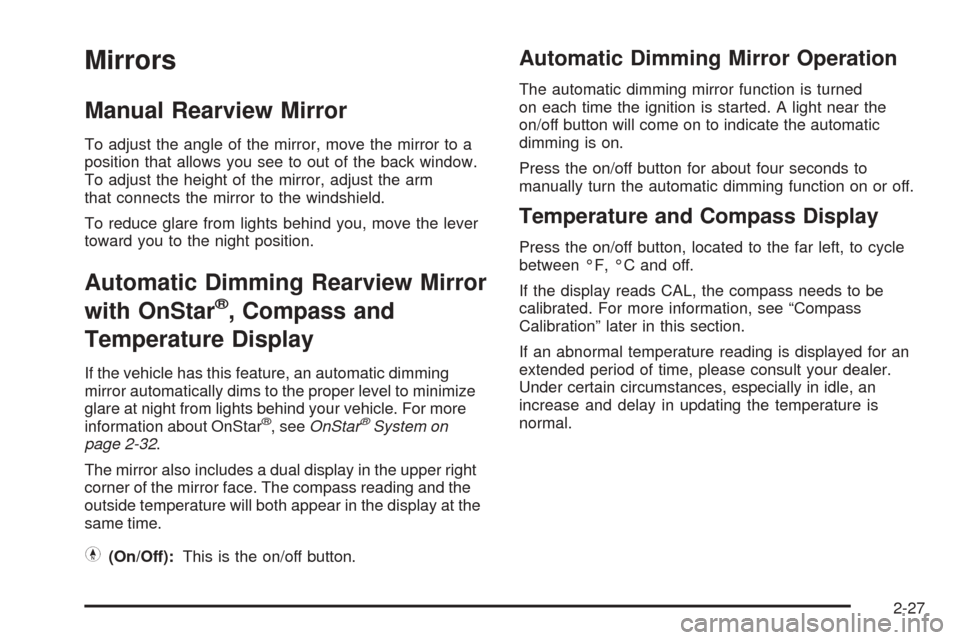
Mirrors
Manual Rearview Mirror
To adjust the angle of the mirror, move the mirror to a
position that allows you see to out of the back window.
To adjust the height of the mirror, adjust the arm
that connects the mirror to the windshield.
To reduce glare from lights behind you, move the lever
toward you to the night position.
Automatic Dimming Rearview Mirror
with OnStar
®, Compass and
Temperature Display
If the vehicle has this feature, an automatic dimming
mirror automatically dims to the proper level to minimize
glare at night from lights behind your vehicle. For more
information about OnStar
®, seeOnStar®System on
page 2-32.
The mirror also includes a dual display in the upper right
corner of the mirror face. The compass reading and the
outside temperature will both appear in the display at the
same time.
Y(On/Off):This is the on/off button.
Automatic Dimming Mirror Operation
The automatic dimming mirror function is turned
on each time the ignition is started. A light near the
on/off button will come on to indicate the automatic
dimming is on.
Press the on/off button for about four seconds to
manually turn the automatic dimming function on or off.
Temperature and Compass Display
Press the on/off button, located to the far left, to cycle
between °F, °C and off.
If the display reads CAL, the compass needs to be
calibrated. For more information, see “Compass
Calibration” later in this section.
If an abnormal temperature reading is displayed for an
extended period of time, please consult your dealer.
Under certain circumstances, especially in idle, an
increase and delay in updating the temperature is
normal.
2-27